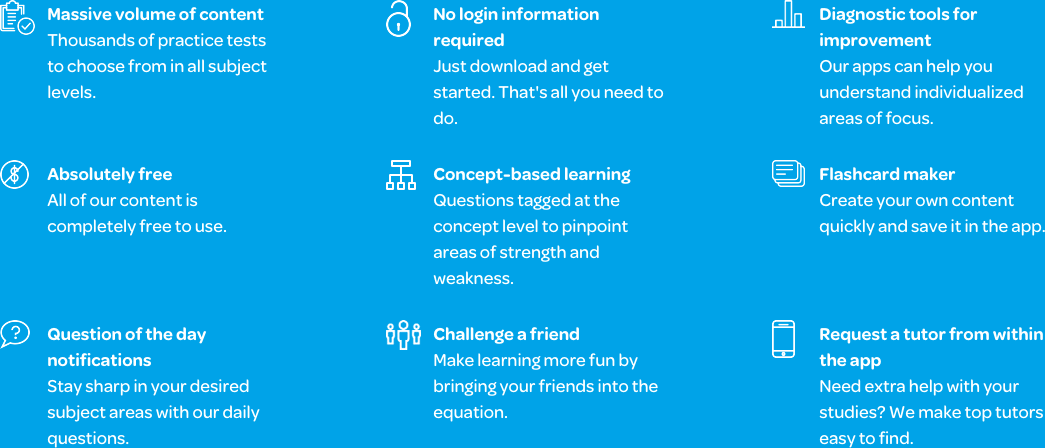The Varsity Tutors Basic Arithmetic Mobile App
Basic Arithmetic is a class that covers the introductory concepts of mathematics. Your child will primarily be taught elementary operations, with the addition of a few advanced concepts, like manipulation of square roots, logarithms, and percentages. Before your child can progress to more advanced classes in math, they must pass the introductory course. You can support your child’s learning by providing them with access to learning tools that may help improve the effectiveness of their studying. As your child progresses in their class and studies, it will build the confidence and skills they will need moving forward.
If you find that your child has been exhibiting difficulties while working with the fundamental concepts of basic arithmetic, such as fractions, mixed numbers, data sets, and other topics, they may benefit from the clarity offered by the free Varsity Tutors Basic Arithmetic app. The app is available for iPhone, iPad, and Android devices from iTunes and the Google Play Store. It provides a variety of learning tools that are designed to simplify the core concepts of basic arithmetic while providing detailed results regarding their skills.
The app provides materials on the specific concepts in basic arithmetic that your child finds most challenging. There are hundreds of materials to use, including full-length practice tests, concept-specific practice tests, daily questions, flashcards, and more. Parents can receive reports on their child’s efforts and progress, and can program the study materials to focus on specific concepts. Through each of these tools, either alone or in combination, students are able to practice their skills at every opportunity.
Your child can use the app to study on their own or with other students in their class. The app's hundreds of flashcards are designed to test their aptitude in basic math skills. You and your child can also create custom flashcards based on their coursework and focus.
The concept-specific and full-length practice tests are based upon the criteria used by schools to evaluate a student’s performance and readiness to advance to the next level in math. This means that the questions will be similar to what your child may see on his or her tests. By taking practice tests that simulate real exams, your child can get valuable, stress-free practice.
You can determine which areas to direct your child’s attention to through the app’s full-length practice tests, which provide a comprehensive review of your child’s score, broken down by concept area. You can see their results in comparison to other test-takers, the amount of time spent per concept area, and the type of problems they faced as they worked. Plus, you can track your child’s progress to measure how the extra practice has affected his or her basic arithmetic understanding.
Through the free Varsity Tutors Basic Arithmetic app for Android and Apple devices, your child can review a whole host of individual topics, no matter where he or she is. Using the app, your child will have the necessary resources available at the touch of a finger.
66 mobile apps to choose from for your tutoring needs.

Learn More
Basic Arithmetic provides the fundamental basis of understanding for advanced math classes one may take in high school or college. This isn’t just addition, subtraction, multiplication, and division, though these four cornerstones of mathematical understanding are certainly part of the curriculum. The course covers a wide range of mathematical topics, both simple and complex. It is through these lessons that your child begins to develop the skills they will need in order to be successful in higher education. In the case that Basic Arithmetic is taken as a remedial course or for a degree requirement, it also serves as excellent preparation for the real world. The topics covered here are often applicable in everyday life.
There are six core topics that your child will be introduced to during the class. They may be tested on their understanding of these topics with a state assessment or final exam. Your child will need to be able to both recall and implement solutions. They will have to work with shapes, such as rectangles and circles, manipulate line segments, and use fractional language. In addition, they will need to be able to call on particular skills, such as perceptual subitizing, conceptional subitizing, basic counting, and answering situational problems. The amount of time that your child will have to complete the full test depends on the school or school district.
One of the important topics covered by Basic Arithmetic is statistics. Your child will spend his or her time in class solving a variety of basic statistics problems that revolve around range, median, mean, and mode. Your child will be taught to understand the differences between each, as well as the formulas necessary to achieve the correct results. They will work to develop the ability to select the appropriate approach for various data sets. It’s also likely they will get some exposure to word problems that challenge them to think about the principles of statistics in novel ways.
Another core topic of Basic Arithmetic is fractions. When your child beings to work with fractions, they will be introduced to the way fractions work. They will learn to solve for the least common denominator from a set of multiple fractions. In addition, they will begin working with linear equations, mixed numbers, and performing fundamental operations on fractions. By the end of this section, your child should be capable of identifying reciprocals, working with mixed number fractions, and should have a good understanding of how multiplication and division work within this concept.
Money and time is the next major topic covered in Basic Arithmetic. Since these are such an integral part of everyday life, expect to see plenty of word problems applying the concepts learned during this unit in your child’s homework. As part of this topic, your child will work with the manipulation of time and money. They will learn the basics behind linear equations involving both principles, as well as how to use multiplication, addition, division, and subtraction with money.
Using operations in expressions, including algebraic expressions, represents a step up in complexity for Basic Arithmetic. Some children may take additional time to work through these more difficult, multi-step problems. They will learn about factoring, how it compares to multiplication, and how it is implemented with various factors. Performing operations on exponents utilizing the laws of exponents is also covered in this unit, including what to do in the case of fractions. Order of operations is essential for understanding how to solve an equation correctly, and that is also covered in this unit.
The next major topic in Basic Arithmetic is decimals and percentages. Your child will learn how to make the changes from percent to decimal and back again. In addition, they will learn the necessary formulas to change a fraction to a percent and back. Furthermore, your child will be tasked with creating and solving linear equations that involve whole, part, and percent numbers. Finally, your child will learn how to find the change between increasing and decreasing percentages. They will need to be able to identify this change as a percent, whole, and partial number.
Building upon the previous topics, rates and ratios takes Basic Arithmetic a few steps further. Your child will learn to be able to identify the difference between percentages, rates, and ratios, as well as how to form linear equations using rates and ratios. They will learn to transform a ratio into its most simplistic form, as well as to work on simplifying rates, solving world problems based on each, and forming proportions through examples. In addition, your child will begin working with ratio tables and solving them with graphs. Your child's teacher will spend some time working with the class on unit conversions, such as volume, pounds and ounces, yards and inches, word problems based on units, and measurement problems.
Rounding out the core topics of Basic Arithmetic are whole numbers. Your child will learn how to use whole numbers to create and solve equations, including those with multiple variables. In addition, they will take whole numbers and learn to apply them to operations, such as rounding, multiplication, division with remainders, addition, and subtraction. Your child will need to demonstrate an understanding of long division, multiplication with triple digit numbers, and more.
Basic Arithmetic is the foundation that future math courses build upon. Math courses progress based on previous learning, taking these core topics and solidifying them, providing new information, and offering ways to expand your child’s mathematical knowledge into much more complex ideas. Students that are successful in their early math classes have a tendency to be more successful in the future, as they have a deeper vault of information to pull from. As a parent, it is up to you to ensure that your child gets ample practice in their earlier classes to help them have a greater chance of further success in school. And even if your child doesn’t pursue a career that requires a lot of math understanding, they’ll be thankful for their Basic Arithmetic training when they’re managing a budget, working with recipes, financing a vehicle, and more.




